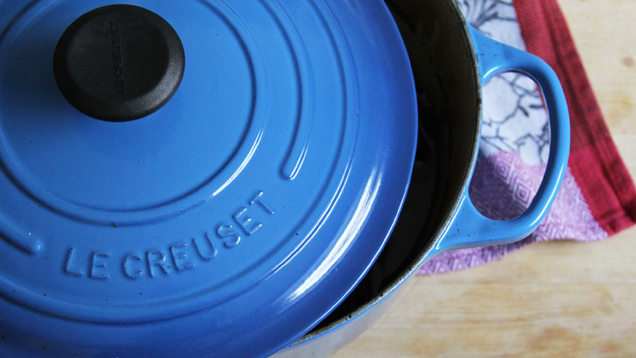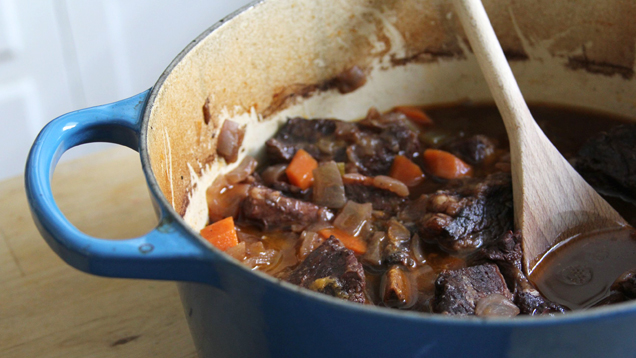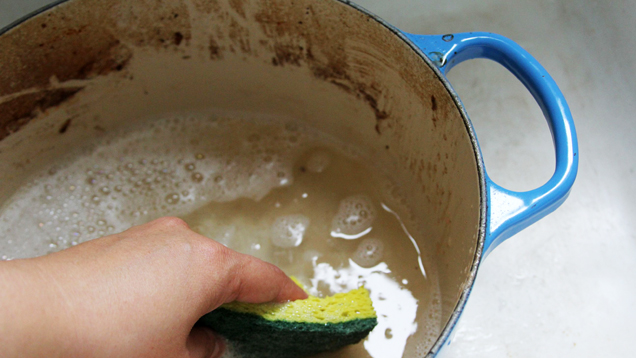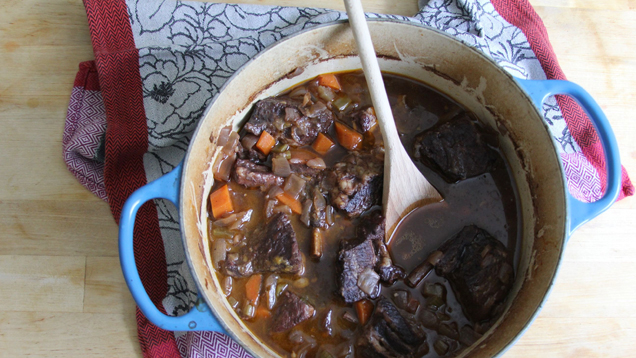We’ve already mentioned that a cast iron pan is one of those absolute, must-have items for any kitchen, whether you’re an expert cook or just an occasional one. Well, here’s another workhorse that belongs on every stove: the enamelled cast iron Dutch oven pot.
Like our beloved skillets, these pots (also known as French ovens, casseroles or cocottes) are made of cast iron; the difference is that they’re coated with an oven-safe enamel glaze. This adds a slew of convenient advantages:
- The enamel has the durability of bare cast iron, but none of its issues with rusting, iron leaching, or interactions with acidic foods.
- There’s no need to season the cast iron with oil.
- The enamel can handle a dishwasher cycle or cleaning with traditional dishwashing detergent.
- Enamelled cast iron is thicker and heavier than steel or copper pots, and as a result, retains and conducts heat more effectively.
- The pot’s volume capacity and high walls allows it to hold more content than its skillet counterpart.
The result: an everyday go-to for braising, stewing, frying, boiling, baking, and just about anything in between.
How to Find The Right Enamelled Dutch Oven For You

Aside from the enamel coating, the biggest difference between traditional cast iron and enamelled cast iron cookware is the price. Enamelled cookware is significantly more expensive. An enamelled Dutch oven is a financial investment: the labour and raw material cost of coating the cast iron in vitreous enamel makes it significantly more costly.
The brand that’s most synonymous with this type of cookware is Le Creuset, a French brand that, for a long time, was one of the only enamelled cast iron options on the market.
In the interest of full disclosure, Le Creuset sent me a tester Dutch oven unit to review. But I also own several Le Creuset pieces independently, and they have all stood the test of time (and should last decades if properly cared for). That being said, there are plenty of other alternatives: Staub and Chasseur offer a similar level of quality (and warranty) to the Le Creuset at a comparable price.
If you spot an unrecognisable brand at a price that sounds too good to be true, you may risk the possibility of cracking or chipping after heavy use (something less likely to happen with the expensive versions). That being said, as long as your pot is heavy and durable, many of the options listed here are solid ones — the biggest differences you’ll see are small tweaks in design (rounder shape, different fit of the lid, type of handle, and so forth).
Although enamelled ovens come in a wide range of sizes, a 5 1/2 or 6-quart is a good starting point: it’s large enough to accommodate a wide range of meats and roasts, but all-purpose enough to fit on most stovetops. We prefer round pans, not only for their appearance but also because they cook most evenly on the stovetop and are easiest to clean. If you frequently cook large, long roasts like leg of lamb or pork belly, oval is another option. Its shape can also be easier to fit on the stovetop when you’re using other burners at the same time, and need to create a little more working space.
How To Cook With Your Enamelled Oven

Because of their extremely thick walls and lid, enamelled cast iron ovens transfer heat gradually and gently, retain temperature nicely, and keep evaporation to a minimum. But for the same reason, they take longer to heat up — if you’re used to cooking with fast-heating stainless steel, you’ll need to account for that when sautéing or searing.
Enamelled cast iron pots are the best choice for pot roasts, carnitas, lamb shoulder — basically, any cooking method that might start on the stovetop with browning or searing, but end with a long braise in the oven. My favourite recipe to test in this Dutch oven was red wine-braised short ribs — thanks to the heaviness of the cast iron, they browned reliably, leaving lots of browned bits behind on the bottom of the pan, but took well to the addition of a high-acid red wine that I used as simmering liquid afterward.
The hefty 5.5-quart size also makes them a good vehicle for deep-frying potatoes, fish fillets, or cardoons, as I did recently; it’s a good size for boiling pasta in as well. You can even use a Dutch oven to bake up a loaf of crusty, no-knead bread.
Note that unlike bare cast iron, enamelled cast iron doesn’t develop better nonstick properties over time. In fact, I wouldn’t recommend enamelled cast iron ovens for cooking anything prone to sticking (e.g., a recipe that entails scrambling eggs, for instance). But that’s OK: it’s a very small trade-off for not having to season them after every use.
Caring For Your Enamelled Oven

Carefree clean-up is one of the best parts of enamelled Dutch ovens. Simply wash yours with soap and hot water in the sink, or clean it in the dishwasher like you would with other dishes. There’s no rush to dry them for fear of rusting, no need to season them, and no fear of scraping away at their surface.
To remove stubborn food residue, let the pot soak in warm, soapy water for 15 to 20 minutes before washing; scrub away using a brush or a nylon abrasive pad (avoid metallic pads like steel wool). Browning stains will naturally occur over time, but using laundry detergent and dryer sheets will help minimise them. (Fading enamel sheen can also occur, and this can be remedied by applying a coat of white vinegar on the cookware until your next use.) And in the event that you walk away from cooking and return to a burnt mess, restore your enamelled cookware with bicarb soda, and it will be as good as new.
When it comes to enamelled cookware, cracking and chipping of the enamel surface are the biggest concerns. It usually occurs via thermal shock, so you should avoid washing a still-hot piece of cookware in cold water. Dragging the pot is another no-no, since it may permanently damage the enamel. And be sure to use soft padding if you plan on stacking your cookware in storage, to avoid scrapes and chips.
If you chip your pot a little, especially if the chip is on the outside, it’s still safe to use; just be sure to coat the chipped area with oil that has a high smoking point, like flaxseed, to keep moisture out. If the chip is significant, and on the inside, it’s probably worth contacting the manufacturer directly to get more specific recommendations.

Comments
One response to “Kitchen Tool School: The Workhorse Enamelled Dutch Oven”
Dutch ovens produce a far tastier outcome in my opinion, the ability to sear meat in the same dish you end up stewing it in adds a whole new level of flavour.